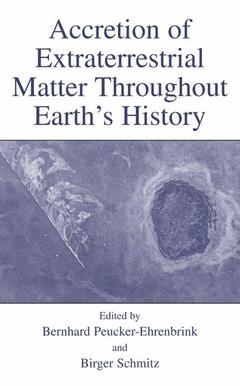Description
Accretion of Extraterrestrial Matter Throughout Earth’s History, 2001
Coordinators: Peucker-Ehrenbrink Bernhard, Schmitz Birger
Language: English
Subject for Accretion of Extraterrestrial Matter Throughout...:
Keywords
Planet; Sediment; Solar System; asteroid; cosmic ray; earth; moon; solar
Accretion of Extraterrestrial Matter Throughout Earth's History
Publication date: 09-2012
466 p. · 15.5x23.5 cm · Paperback
Publication date: 09-2012
466 p. · 15.5x23.5 cm · Paperback
Accretion of extraterrestrial matter throughout earth's history
Publication date: 10-2001
492 p. · Paperback
Publication date: 10-2001
492 p. · Paperback
Description
/li>Contents
/li>
Every year Earth is bombarded with about 40,000 tons of extraterrestrial material. This includes microscopic cosmic dust particles shed by comets and asteroids in outer space, meteorites, as well as large comets and asteroids that have led to catastrophic events in the geologic past. Originally considered only a curiosity, extraterrestrial matter found on Earth provides the only samples we have from comets, asteroids and other planets. Only recently mankind has started to actively collect extraterrestrial matter in space (Apollo program, Stardust mission) rather than to wait for its delivery to Earth. Still, most of our knowledge of the origin and evolution of our solar system is based on careful studies of meteorites, cosmic dust, and traces of large impact events in the geologic record such as the mass extinction that terminated the Cretaceous Period and led to the extinction of the dinosaurs.
This book summarizes our current knowledge of the properties, origin, orbital evolution and accretion mechanism of extraterrestrial matter accreted on Earth and sheds light on accretion processes and fluxes in the geologic past. The chapters in the first part of the book are arranged in order to follow extraterrestrial matter from its origin in space, its orbital evolution on its way to Earth, its interaction with the Earth magnetosphere and atmosphere to its more or less violent collision with the Earth's surface. In the second part of the book several chapters deal with the present?day flux of cosmic dust and meteorites to Earth. Finally, several chapters deal with the reconstruction of the accretion history of extraterrestrial matter on Earth, starting with the most recent geologic past and ending with the very early, violent accretion period shortly after the formation of Earth, Moon and other solid planets in our solar system.
This book summarizes our current knowledge of the properties, origin, orbital evolution and accretion mechanism of extraterrestrial matter accreted on Earth and sheds light on accretion processes and fluxes in the geologic past. The chapters in the first part of the book are arranged in order to follow extraterrestrial matter from its origin in space, its orbital evolution on its way to Earth, its interaction with the Earth magnetosphere and atmosphere to its more or less violent collision with the Earth's surface. In the second part of the book several chapters deal with the present?day flux of cosmic dust and meteorites to Earth. Finally, several chapters deal with the reconstruction of the accretion history of extraterrestrial matter on Earth, starting with the most recent geologic past and ending with the very early, violent accretion period shortly after the formation of Earth, Moon and other solid planets in our solar system.
In Memoriam - Paolo Farinella; D. Vokrouhlický. List of Contributors. Foreword; W. Alvarez. Preface. Acknowledgments. 1. The origin and properties of dust impacting the Earth; D.E. Brownlee. 2. Sources and orbital evolution of interplanetary dust accreted by Earth; S.J. Kortenkamp, et al. 3. Delivery of material from the asteroid belt; P. Farinella. 4. The Influx of comets and their debris; W.M. Napier. 5. Spacecraft measurements of the cosmic dust flux; H.A. Zook. 6. Magnetospheric effects on the cosmic dust input into the Earth's atmosphere; A. Juhász, M. Horányi. 7. Atmospheric entry heating of interplanetary dust; G.J. Flynn. 8. Extraterrestrial material and stratospheric aerosols; D.M. Murphy. 9. Glacial cycles and interplanetary dust; R.A. Muller. 10. Iridium and osmium as tracers of extraterrestrial matter in marine sediments; B. Peucker-Ehrenbrink. 11. Extraterrestrial helium in seafloor sediments: Identification, characteristics, and accretion rate over geologic time; K.A. Farley. 12. Seeking unbiased collections of modern and ancient micrometeorites; S. Taylor, J.H. Lever. 13. Cosmic ray exposure history of meteorites; R. Wieler, T. Graf. 14. Terrestrial ages of meteorites; A.J.T. Jull. 15. Quantification of meteorite infall rates from accumulations in deserts, and meteorite accumulations on Mars; P.A. Bland. 16. The present-day flux of meteorites to the Earth; I. Halliday. 17. Fossil meteorites; B. Schmitz, M. Tassinari. 18. Thesedimentary record of impact events; C. Koeberl. 19. The terrestrial cratering record; R.A.F. Grieve. 20. The Lunar record of recent impact cratering; J.A. Grier, A.F. McEwen. 21. Accretion to Earth and Moon ∼3.85 Ga; S.J. Mojzsis, G. Ryder. 22. Solar system impact rates measured from lunarspherule ages; R.A. Muller, et al. List of Reviewers. Index.
© 2024 LAVOISIER S.A.S.




